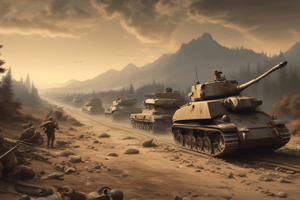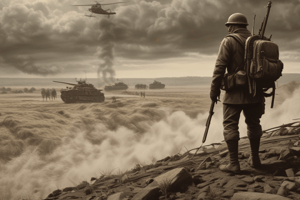Podcast
Questions and Answers
Which of the following was NOT a cause of World War I?
Which of the following was NOT a cause of World War I?
- Militarism
- Nationalism
- Imperialism
- Capitalism (correct)
What was the primary characteristic of trench warfare during World War I?
What was the primary characteristic of trench warfare during World War I?
- Naval warfare played a crucial role
- Static warfare with little territorial gain (correct)
- Highly mobile warfare
- Air power dominated the battlefield
What was the primary role of women on the Home Front during World War I?
What was the primary role of women on the Home Front during World War I?
- They were primarily involved in nursing
- They were restricted from participating in the war effort
- They took on new roles in the workforce (correct)
- They were only involved in propaganda efforts
What was the main goal of the Paris Peace Conference, which led to the Treaty of Versailles?
What was the main goal of the Paris Peace Conference, which led to the Treaty of Versailles?
What was the significance of the Battle of the Argonne Forest?
What was the significance of the Battle of the Argonne Forest?
What was the main provision of the Treaty of Versailles that forced Germany to accept responsibility for the war?
What was the main provision of the Treaty of Versailles that forced Germany to accept responsibility for the war?
Flashcards are hidden until you start studying
Study Notes
Causes of the War
- Imperialism: European powers competing for colonies and resources
- Nationalism: Rise of nationalist movements in various countries, leading to tensions and rivalries
- Militarism: Build-up of military forces and glorification of war
- Alliances: Complex system of alliances between European powers, including the Triple Entente (France, Britain, Russia) and the Triple Alliance (Germany, Austria-Hungary, Italy)
- Assassination of Archduke Franz Ferdinand: Spark that ignited the war, leading to a chain reaction of events and ultimatums
Trench Warfare
- Static warfare: Both sides dug in along a 450-mile front, with little movement or territorial gain
- Trench system: Elaborate network of trenches, including front lines, support lines, and communication lines
- Conditions: Dirty, unsanitary, and crowded conditions, with soldiers exposed to mud, lice, and rats
- Tactics: Both sides employed tactics such as artillery bombardments, machine gun fire, and trench raids
- Stalemate: Trench warfare led to a stalemate, with neither side able to break through the other's defenses
Home Front
- Total war: Governments mobilized entire populations and economies to support the war effort
- Rationing: Food, fuel, and other essential resources were rationed to support the military and maintain public morale
- Women's roles: Women took on new roles in the workforce, including in industries and agriculture
- Propaganda: Governments used propaganda to boost morale, demonize enemies, and promote war efforts
- Civil liberties: Governments restricted civil liberties, including freedom of speech and assembly, in the name of national security
Treaty of Versailles
- Paris Peace Conference: Allied leaders met to negotiate the treaty, with goals of punishing Germany and preventing future wars
- Key provisions: Germany accepted responsibility for the war, surrendered territory, and agreed to pay reparations
- War guilt clause: Article 231 of the treaty, which forced Germany to accept responsibility for the war
- League of Nations: The treaty established the League of Nations, an international organization aimed at promoting diplomacy and preventing future wars
Argonne Forest
- Battle of the Argonne Forest: One of the final and bloodiest battles of the war, fought in northeastern France
- American Expeditionary Forces: US troops played a key role in the battle, which lasted from September 26 to November 11, 1918
- Meuse-Argonne Offensive: The battle was part of a larger Allied offensive, which ultimately led to the defeat of Germany and the end of the war
- Casualties: The battle resulted in over 100,000 casualties, including over 26,000 American deaths
Studying That Suits You
Use AI to generate personalized quizzes and flashcards to suit your learning preferences.




